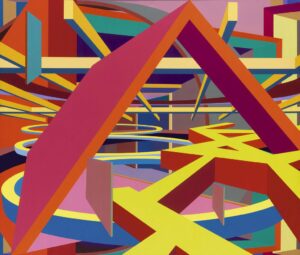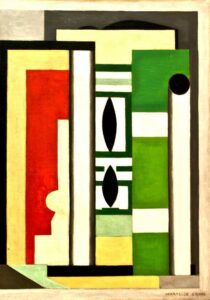Hard-edge painting is a gem in the crown of abstract art, known for its crisp edges and bold color blocks.
It’s a technique that strips away the nuances of shade and texture, inviting viewers into a world of geometric precision.
We’ll jump into the origins of this striking style and its impact on the art world.
Stay with us as we explore how hard-edge painting became a pivotal movement that continues to influence artists today.
Origins Of Hard-edge Painting
Hard-edge painting emerged as a distinct style in the post-World War II era, notably among artists in the American West Coast.
As devotees of fine arts, we recognize this period as a significant shift in artistic vision, one that prized geometrical precision over the spontaneous brushwork associated with Abstract Expressionism.
California became a fertile ground for the development of this style, where artists such as John McLaughlin and Lorser Feitelson laid the groundwork for hard-edge’s unique aesthetics.
The term “hard-edge painting” was first coined by the writer, critic, and historian Jules Langsner.
He observed a common thread in the works created by these artists – their shared interest in clarity, simplicity, and the elimination of excess.
These characteristics crystallized into a formalized art movement due to their:
- Reduction of visual elements to the bare essentials,
- Use of flat and uninterrupted colors,
- Emphasis on sharp, clean lines to delineate forms.
With its roots in the modernist practices of the early 20th century, hard-edge painting drew upon various sources for inspiration.
The movement’s influences range from the Bauhaus principles of design to the serene simplicity of Zen Buddhism.
Notably, the bold simplicity of Suprematism and Neoplasticism also informed hard-edge techniques, emphasizing form and color over representational content.
While the art world often credits the West Coast scene for the birth of hard-edge painting, this style is reflective of a broader movement towards minimalism and abstraction in the global art community.
Artists such as Ellsworth Kelly and Frank Stella on the East Coast were simultaneously experimenting with similar concepts, adding to the rich tapestry that defines hard-edge painting.
As a movement that blurred geographical confines, it opened up dialogues across the art world, presenting a shared language of form and color that spoke to audiences regardless of location.
Characteristics Of Hard-edge Painting
Hard-edge painting is recognized by its precise geometric shapes and distinctly defined color areas.
The boundaries between these colors are often so sharp that it appears as if they were cut with a razor or edged with a knife.
In contrast to expressionist or impressionist works, which often feature loose brushwork, hard-edge paintings typically employ flat, solid colors.
These meticulously applied areas of paint lack visible brushstrokes, emphasizing the purity of the colors and the flatness of the surface.
Visual Clarity Through Simplification
- The compositions in hard-edge paintings are streamlined for visual clarity. This is achieved through: – Reduction of forms to basic geometric shapes – Minimal gradation within color fields – Limited color palettes that enhance the visual impact.
Artists like McLaughlin and Feitelson pursued an aesthetic that was both modern and timeless, anchored in the present while rejecting narrative and representational content.
Interaction Of Color And Space
The spatial relationships between colors in hard-edge painting are carefully considered.
By juxtaposing certain hues, artists could create the illusion of depth on an otherwise flat plane.
The use of negative space is also pivotal, serving to frame and balance the composition without extra embellishment.
Hard-edge works do not just reside within the realm of painting.
Filmmakers and digital artists have embraced these principles as well, utilizing hard-edge techniques to compose visually arresting scenes and graphics.
In pieces like Broadway Boogie Woogie, Piet Mondrian’s influence on both fine art and digital design underscores the versatility and broad appeal of the hard-edge aesthetic.
As we further explore how hard-edge painting integrates into various creative mediums, it’s evident that its principles transcend beyond the canvas.

Whether through the lens of a camera or the screen of a digital animator, the crisp, clean lines and bold color schemes of hard-edge find new life in contemporary visual storytelling.
Influence Of Hard-edge Painting On The Art World
Hard-edge painting has left an indelible mark on the art world, influencing a variety of artistic practices beyond its initial emergence.
Its impact can be traced from the canvases of the mid-20th century right through to the digital aesthetics of the 21st century.
Artists across the globe have been inspired by the movement’s emphasis on color field painting and the visually striking effects that can be accomplished with sharply delineated areas of color.
From minimalist works to the bustling world of Pop Art, the techniques and aesthetic principles of hard-edge painting have been adopted and adapted by artists seeking to convey clarity and immediacy in their work.

Filmmakers and Digital Artists
- Embrace hard-edge painting’s meticulous boundaries and rich color palettes,
- Use geometric shapes to create abstract narratives,
- Incorporate negative spaces in scene compositions to enhance visual tension.
Hard-edge painting’s aesthetic principles resonate particularly well with our digital era.
The precision and clarity that define hard-edge works align seamlessly with the realm of digital design, where clean lines and bold colors are often
The influence on contemporary design and architecture is undeniable, with hard-edge painting’s legacy permeating through:
- The crisp lines and bold color blocking common in modern graphic design,
- Architectural structures that emphasize geometric form over ornamentation,
- Interior design that reflects the movement’s minimalism and focus on spatial relationships.
It’s the simplicity and directness of hard-edge painting that has made it a lasting source of inspiration in the art world.
We see its echoes in commercial design, where striking visuals are essential, and its fundamentals interwoven with the tenets of branding and advertising.
In the dynamic flow of cultural expression, hard-edge painting continues to inform and inspire new generations of creators.
Its principles serve as building blocks for artists and designers who push the boundaries of what is visually and conceptually possible.
Contemporary Artists Inspired By Hard-edge Painting
As connoisseurs of art history, we’ve observed a new wave of contemporary artists who draw heavily from the hard-edge painting style.
These creatives forge bold paths by integrating the movement’s stark lines and vivid color fields into their own innovative works.
We’ve noticed that Sarah Morris stands out among her peers.
Her large-scale works embody the clarity and precision inherent to hard-edge painting.
Yet, she infuses a dynamism that is distinctly her own.
The interplay of color and geometry in her series Los Angeles engages viewers with a reflection of the city’s fragmented narrative.
In the realm of moving images, some film directors have channeled hard-edge aesthetics to craft visually striking scenes.
The meticulously designed shots in Drive, with its neon-drenched palettes, parallel hard-edge’s fascination with pure color and form, evoking a sense of stylized realism that’s become a hallmark of modern cinema.
Artists Across the Spectrum:
- James Turrell’s immersive light installations manipulate space and perception, roots traceable to hard-edge’s preoccupation with the experiential aspect of art.
- Bridget Riley’s optical illusions play with viewers’ perception, a nod to the hard-edge pursuit of creating new visual experiences.
- The minimalistic sculptures of Donald Judd, often categorized under Minimalism, bear a clear lineage to the reductive aesthetics of hard-edge painting.
Technological advancements have enabled a cross-pollination of hard-edge principles with digital art forms.
In the evolving digital landscape, these artists convey complex narratives through geometric precision, showcasing the versatility and timelessness of the hard-edge philosophy.
This is evident in the sharp vector lines and crisp transitions that we see in high-end graphic animations, which owe much to the movement’s legacy.
to conclude – oops, we’ve forgotten, we’re not here for the wrap-up.
Let’s press on, there’s more to explore in the exciting world of contemporary art.
What Is Hard Edge Painting – Wrap Up
We’ve seen hard-edge painting’s enduring influence across various creative domains, from contemporary art to digital media.
Artists like Sarah Morris continue to push the boundaries, integrating the movement’s defining characteristics into fresh, innovative works.
As technology evolves, the fusion of hard-edge principles with new mediums is a testament to the style’s versatility and relevance.
Hard-edge painting remains a dynamic force, shaping the aesthetic of our built environments and the narratives we craft in film and digital spaces.

It’s clear that the crisp lines and bold colors of this art form will keep inspiring creators for years to come, proving that hard-edge painting is much more than a historical footnote—it’s a living language in the visual dialogue of our time.
Frequently Asked Questions
What Is Hard-edge Painting?
Hard-edge painting is an art style characterized by its strict, geometric boundaries, rich color palettes, and precise delineations between areas of color, often leading to a flat, two-dimensional appearance.
How Has Hard-edge Painting Influenced Filmmakers And Digital Artists?
Filmmakers and digital artists have adopted hard-edge painting’s sharp boundaries and bold colors, using geometric shapes and careful composition to create abstract narratives and augment visual tension in their works.
What Impact Has Hard-edge Painting Had On Contemporary Design And Architecture?
Contemporary design and architecture have been influenced by hard-edge painting through the use of clean lines, geometric forms, negative space, and a vibrant color palette, which can be seen in modern graphic design, architectural structures, and interior design.
Who Are Some Contemporary Artists Inspired By Hard-edge Painting?
Sarah Morris is an example of a contemporary artist who incorporates hard-edge painting principles into her innovative works, often drawing on the movement’s style for inspiration.
How Has Technology Influenced The Integration Of Hard-edge Principles Into Other Art Forms?
Technological advancements have facilitated the blending of hard-edge principles with digital art forms, allowing artists to explore and push the boundaries between traditional painting techniques and new media.
Matt Crawford
Related posts
2 Comments
Leave a Reply Cancel reply
This site uses Akismet to reduce spam. Learn how your comment data is processed.



Oh my goodness! Awesome article dude!
Hard edge painting is a tough subject to explain. Well done.
Thanks!